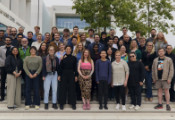The Technique Provides Researchers With a Powerful Tool for Controlling Magnetism, and Could Help in Designing Faster, Smaller, More Energy-Efficient Memory Chips.
December 18, 2024 -- MIT physicists have created a new and long-lasting magnetic state in a material, using only light.
In a study appearing today in Nature, the researchers report using a terahertz laser — a light source that oscillates more than a trillion times per second — to directly stimulate atoms in an antiferromagnetic material. The laser’s oscillations are tuned to the natural vibrations among the material’s atoms, in a way that shifts the balance of atomic spins toward a new magnetic state.
The results provide a new way to control and switch antiferromagnetic materials, which are of interest for their potential to advance information processing and memory chip technology.
In common magnets, known as ferromagnets, the spins of atoms point in the same direction, in a way that the whole can be easily influenced and pulled in the direction of any external magnetic field. In contrast, antiferromagnets are composed of atoms with alternating spins, each pointing in the opposite direction from its neighbor. This up, down, up, down order essentially cancels the spins out, giving antiferromagnets a net zero magnetization that is impervious to any magnetic pull.
If a memory chip could be made from antiferromagnetic material, data could be “written” into microscopic regions of the material, called domains. A certain configuration of spin orientations (for example, up-down) in a given domain would represent the classical bit “0,” and a different configuration (down-up) would mean “1.” Data written on such a chip would be robust against outside magnetic influence.
For this and other reasons, scientists believe antiferromagnetic materials could be a more robust alternative to existing magnetic-based storage technologies. A major hurdle, however, has been in how to control antiferromagnets in a way that reliably switches the material from one magnetic state to another.
“Antiferromagnetic materials are robust and not influenced by unwanted stray magnetic fields,” says Nuh Gedik, the Donner Professor of Physics at MIT. “However, this robustness is a double-edged sword; their insensitivity to weak magnetic fields makes these materials difficult to control.”
Using carefully tuned terahertz light, the MIT team was able to controllably switch an antiferromagnet to a new magnetic state. Antiferromagnets could be incorporated into future memory chips that store and process more data while using less energy and taking up a fraction of the space of existing devices, owing to the stability of magnetic domains.
“Generally, such antiferromagnetic materials are not easy to control,” Gedik says. “Now we have some knobs to be able to tune and tweak them.”
Gedik is the senior author of the new study, which also includes MIT co-authors Batyr Ilyas, Tianchuang Luo, Alexander von Hoegen, Zhuquan Zhang, and Keith Nelson, along with collaborators at the Max Planck Institute for the Structure and Dynamics of Matter in Germany, University of the Basque Country in Spain, Seoul National University, and the Flatiron Institute in New York.
Off balance
Gedik’s group at MIT develops techniques to manipulate quantum materials in which interactions among atoms can give rise to exotic phenomena.
“In general, we excite materials with light to learn more about what holds them together fundamentally,” Gedik says. “For instance, why is this material an antiferromagnet, and is there a way to perturb microscopic interactions such that it turns into a ferromagnet?”
In their new study, the team worked with FePS3 — a material that transitions to an antiferromagnetic phase at a critical temperature of around 118 kelvins (-247 degrees Fahrenheit).
The team suspected they might control the material’s transition by tuning into its atomic vibrations.
“In any solid, you can picture it as different atoms that are periodically arranged, and between atoms are tiny springs,” von Hoegen explains. “If you were to pull one atom, it would vibrate at a characteristic frequency which typically occurs in the terahertz range.”
The way in which atoms vibrate also relates to how their spins interact with each other. The team reasoned that if they could stimulate the atoms with a terahertz source that oscillates at the same frequency as the atoms’ collective vibrations, called phonons, the effect could also nudge the atoms’ spins out of their perfectly balanced, magnetically alternating alignment. Once knocked out of balance, atoms should have larger spins in one direction than the other, creating a preferred orientation that would shift the inherently nonmagnetized material into a new magnetic state with finite magnetization.
“The idea is that you can kill two birds with one stone: You excite the atoms’ terahertz vibrations, which also couples to the spins,” Gedik says.
Shake and write
To test this idea, the team worked with a sample of FePS3 that was synthesized by colleages at Seoul National University. They placed the sample in a vacuum chamber and cooled it down to temperatures at and below 118 K. They then generated a terahertz pulse by aiming a beam of near-infrared light through an organic crystal, which transformed the light into the terahertz frequencies. They then directed this terahertz light toward the sample.
“This terahertz pulse is what we use to create a change in the sample,” Luo says. “It’s like ‘writing’ a new state into the sample.”
To confirm that the pulse triggered a change in the material’s magnetism, the team also aimed two near-infrared lasers at the sample, each with an opposite circular polarization. If the terahertz pulse had no effect, the researchers should see no difference in the intensity of the transmitted infrared lasers.
“Just seeing a difference tells us the material is no longer the original antiferromagnet, and that we are inducing a new magnetic state, by essentially using terahertz light to shake the atoms,” Ilyas says.
Over repeated experiments, the team observed that a terahertz pulse successfully switched the previously antiferromagnetic material to a new magnetic state — a transition that persisted for a surprisingly long time, over several milliseconds, even after the laser was turned off.
“People have seen these light-induced phase transitions before in other systems, but typically they live for very short times on the order of a picosecond, which is a trillionth of a second,” Gedik says.
In just a few milliseconds, scientists now might have a decent window of time during which they could probe the properties of the temporary new state before it settles back into its inherent antiferromagnetism. Then, they might be able to identify new knobs to tweak antiferromagnets and optimize their use in next-generation memory storage technologies.
This research was supported, in part, by the U.S. Department of Energy, Materials Science and Engineering Division, Office of Basic Energy Sciences, and the Gordon and Betty Moore Foundation.




































